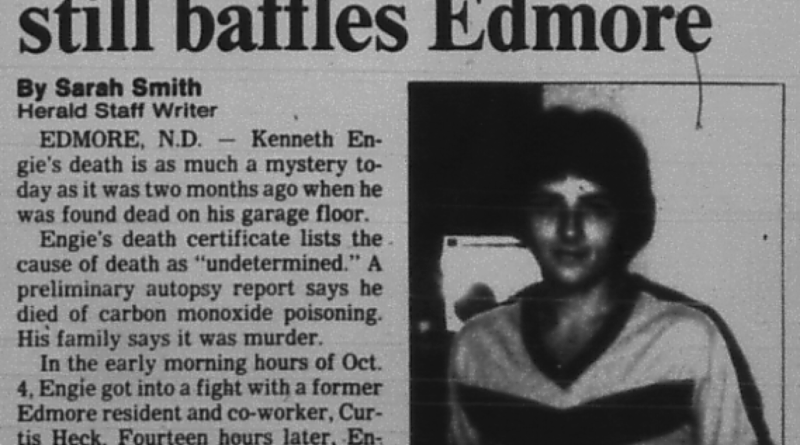Kenneth Engie Found Dead in Garage in Edmore North Dakota
On the afternoon of October 4, 1988, the small farming community of Edmore, North Dakota, was rocked by the mysterious death of 27-year-old auto mechanic Kenneth Dean Engie. A quiet town of just a few hundred residents, Edmore sat amid the rolling plains of Ramsey County, where neighbors knew one another by name and news traveled by word of mouth. Kenneth, known to friends as Kenny, had grown up in the area and worked alongside his uncle, Richard Nygaard, at Nygaard’s Body Shop. With a steady job repairing cars and a reputation as a talented, hardworking young man, Kenny’s sudden, unexplained death would leave questions swirling for decades to come.
October 3, 1988: The Last Evening
Kenny’s final full day began innocuously. Earlier that week, he and several friends attended a regional car race in Hamilton, several miles southwest of Edmore. Kenny later told acquaintances it was the “best day of his life,” celebrating a minor victory for one of his custom projects. Spirits were high when the group returned home, and by evening Kenny found himself at Kunkel’s Bar, a local watering hole frequented by farmers, mechanics, and those looking to unwind after a day’s work.
Inside the dimly lit bar, laughter mingled with the clink of glasses. Kenny reconnected with friends, traded stories about engine rebuilds, and admired the handiwork on a friend’s new transmission. As the night wore on, however, tensions rose. Kenny and fellow patron Curtis Heck—also a mechanic—became embroiled in a heated argument. Witnesses later recalled that the dispute centered on a woman working behind the bar and that Curtis accused Kenny of damaging his pickup truck during a previous encounter. Tempers flared, and in a moment of anger Curtis allegedly pushed Kenny, prompting Kenny to back his Ford Bronco into Curtis’s pickup. Bar staff intervened, and the two parted ways around midnight, each nursing bruised egos and cold resentment.
The Discovery on October 4
Shortly before 3:30 PM the following day, Kenny’s uncle Richard returned to the house adjoining the body shop to drop off parts. Expecting to find Kenny working in the garage, Richard opened the door and was met with an eerie silence. There, slumped across the bench seat of his idling Ford Bronco, lay Kenny, motionless. A thin wisp of exhaust curled into the dim air, and a small, dark stain marked the concrete floor beneath the vehicle. Alarmed, Richard rushed inside and called 911. Law enforcement and emergency medical personnel soon arrived, but by the time they entered the sealed garage, it was clear that Kenny had long since expired.
The Crime Scene Details
What met investigators inside the modest two-car garage confounded conventional explanations:
- Running Vehicle, Ignition Off: Kenny’s Bronco sat with the engine cold but the key still in the “on” position. The exhaust pipe ended mere inches from the closed garage door, suggesting foul or accidental carbon monoxide build-up.
- Loaded Rifle Nearby: Six feet from the body lay a .22-caliber rifle, bolt closed, magazine inserted, and fully loaded—yet no spent shells or bullet fragments indicated it had been fired.
- Pool of Blood: A dark, sticky pool adhered to the concrete next to the passenger door. Doctors later determined the blood did not match Kenny’s, though its source could not be traced.
- Minimal Trauma: Aside from a faint bump on the back of Kenny’s head, no fractures or lacerations appeared on his body. No defensive wounds, no signs of a struggle.
- Near-Full Fuel Tank: The Bronco’s gas tank registered near capacity—odd if Kenny intended to run it for warmth or, as some speculated, for a suicidal purpose.
Taken together, these details painted a perplexing portrait: carbon monoxide poisoning on paper, but anomalies that pointed toward something far more sinister.
Official Investigation and Autopsy
Ramsey County authorities launched a thorough investigation. Officers interviewed Richard Nygaard, bar staff and patrons, and Curtis Heck, who admitted returning to the garage with the barmaid around 3 AM on October 4. Heck claimed he heard muffled groans coming from inside, peered through a dusty window, and believed Kenny was merely sleeping off a drunken stupor. He and the barmaid left rather than attempt a rescue, assuming someone else would check later.
The autopsy revealed a carboxyhemoglobin level of 55.6 percent in Kenny’s blood—well above the 40–50 percent threshold that often proves fatal. Pathologists found no definitive cause of head trauma, ruling out a fatal blow. They listed the official cause of death as carbon monoxide poisoning but flagged the manner of death as “undetermined,” citing the rifle, blood pool, and disabled engine as unexplained factors.
Curtis Heck and the Barmaid Interrogation
When investigators first focused on Curtis Heck, the mechanic who’d clashed with Kenny the night before, they scheduled separate interviews with him and the barmaid who accompanied him to the garage. Over the course of a late-October afternoon, both were brought in to recount their versions of what happened in the early hours of October 4.
Heck maintained that after the bar fight—during which Kenny allegedly rammed Heck’s parked pickup—he and the barmaid left Kunkel’s Bar around 2:45 AM. Driving past Kenny’s home, Heck said he slowed to check the garage when he heard groans. Peering through the grimy window, he saw Kenny slumped over in the driver’s seat of the idling Bronco and assumed intoxication. He claimed he tried the door handle but it was locked; afraid of startling Kenny or drawing unwanted attention, he and the barmaid drove off, believing someone else would check on him soon.
The barmaid’s account aligned in broad strokes but added crucial details: she recalled the engine was running, exhaust puffing through the closed door, and that Kenny’s head fell forward as they approached. She insisted there was no obvious blood at that moment and that neither she nor Heck entered the garage. Under gentle but persistent questioning, she admitted she felt uneasy and considered calling for help but deferred to Heck’s judgment.
Detectives pressed Heck on two inconsistencies: why he wouldn’t break a window or at least leave a note, and why the engine, if cold when they left, would later test as recently turned off. Heck attributed this to panic and the cold—he didn’t want to deal with frozen locks or hurting his friend’s pride. When asked about the loaded rifle found six feet away, he looked puzzled, claiming he never noticed a gun that night. Both Heck and the barmaid passed polygraph exams—though their reliability was disputed—and without forensic evidence of a break-in or third-party presence, authorities eventually accepted their stories as plausible, closing the interrogation phase with no charges filed. Yet the gaps in their accounts fueled family suspicion and kept the case alive in corners of true-crime discussion ever since.
Theories and Speculation
From the outset, investigators and locals speculated on several possible scenarios:
- Accidental Death: Kenny may have run the engine briefly to warm up his work area, misjudged the sealed space, shut off the vehicle, and succumbed to fumes without regaining consciousness.
- Suicide: Some suggested anger or despair after the bar fight could have driven Kenny to take his own life, using the exhaust to do so. Yet his family countered that Kenny, who loved mechanics and life’s small pleasures, had no history of suicidal thoughts.
- Homicide: The bloodstain, rifle, and fight with Curtis Heck fueled suspicions that someone deliberately turned off the engine after incapacitating Kenny—perhaps using the rifle as a threat. Why leave him alive to die slowly remains a chilling question.
- Medical Emergency: A fleeting theory posited that Kenny might have suffered a seizure or sudden cardiac event, collapsed, and inadvertently shut off the engine. Yet this failed to explain the blood or rifle placement.
Despite months of interviews, forensic reviews, and even a segment on a nationally syndicated television show, authorities concluded there was insufficient evidence to charge any individual. The case went cold, filed under “undetermined” and relegated to an ever-growing roster of unsolved mysteries.
Family and Community Response
For the Engie and Nygaard families, official pronouncements offered little comfort. Richard Nygaard, who discovered his nephew, remained haunted by what he saw: the rigid body slumped over, the cold metal of the steering wheel imprinted with blood, and the silent rifle lying just out of reach. Memory of Kenny’s warm laughter at the car race, his proud grin while polishing a fender, seemed incongruous with the gruesome scene.
At community gatherings, whispers filled the air. Some recalled loud banging and muffled shouts in the early morning hours; others insisted they saw headlights at odd hours. Candles flickered under a simple wooden cross placed near the garage entrance. A local pastor led a prayer vigil on the first anniversary, and neighbors left flowers in October each year, unwilling to forget the young man whose life ended under such strange circumstances.
Unresolved Questions and Cold Case Status
Decades later, many questions remain unanswered:
- Who turned off the engine? If Kenny was incapacitated within the cab, how did the key reach the off position?
- Why was the rifle loaded and unused? Was it ever brought to the scene, or did it belong to Kenny? Who left it there?
- What caused the pool of blood? Forensic technology at the time could not identify its source; modern DNA analysis was never applied.
- Where was Curtis Heck between 3 AM and 3 PM? His partial account leaves gaps that investigators never fully reconciled.
- Could sealed-space poisoning be deliberate? Turning a live engine off implies intent to let lethal gas fill the garage.
Law enforcement occasionally reopens the file in light of advancing forensic methods, yet no new evidence has surfaced. The case remains classified under “undetermined death” with zero suspects.
Legacy of the Case
Kenneth Engie’s death endures as a cautionary tale in Edmore and beyond. True-crime podcasts and blogs dedicate episodes to his story, comparing notes between carbon monoxide mysteries across rural America. A handful of amateur sleuths study archived photos and watch the old police footage, convinced overlooked clues may still yield answers.
The body shop where Kenny worked closed years ago, but the detached garage survives, shuttered and locked. Locals say the door still bears a faint scorch mark from the engine’s exhaust pipe. Each October, family members gather in quiet solitude by the cemetery headstone—etched with birth and death dates, his name forever frozen in time—and light candles in his memory. Though no courtroom has ever rendered judgment, the court of public curiosity remains in session, demanding justice for a young man whose final breath remains shrouded in mystery.
Discover more from City Towner
Subscribe to get the latest posts sent to your email.




